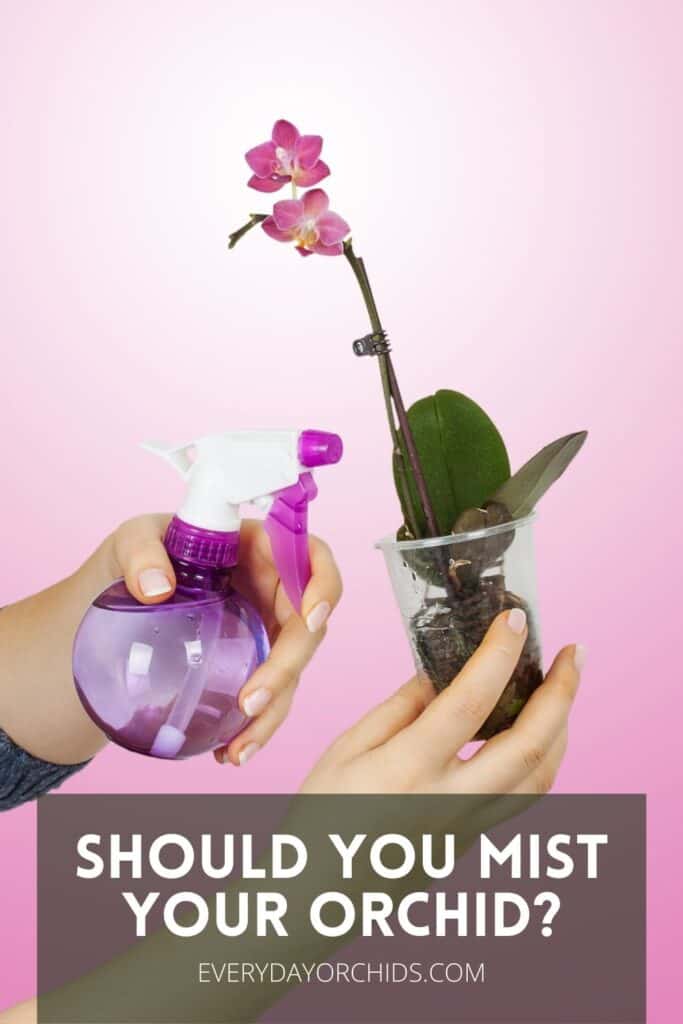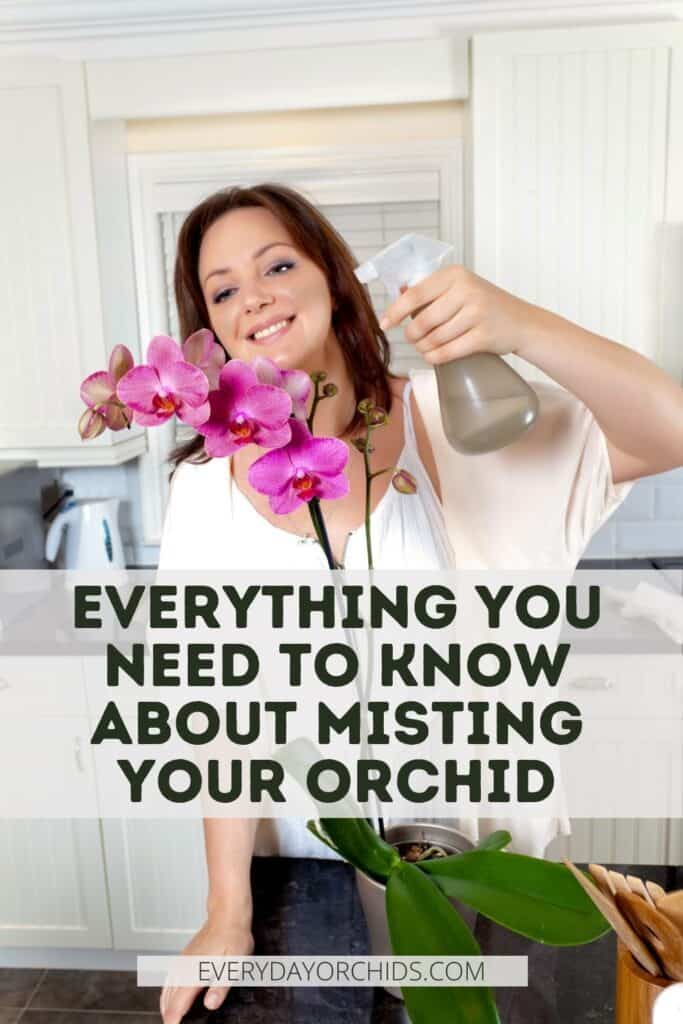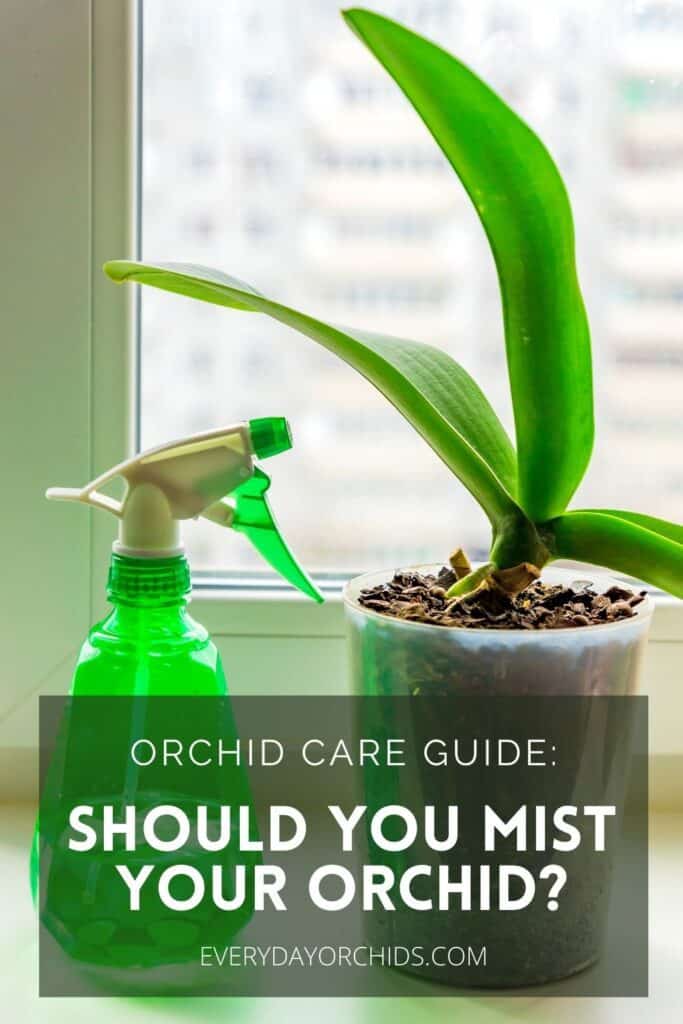If you are new to orchid growing, you may be wondering whether you should mist your orchid or not. It is a simple question, but you may be surprised to find that this is a very controversial topic among orchid growers. Some growers mist their orchids daily, while others say you should never mist your orchid.
In general, misting your orchid is optional. You do not need to mist your orchid in order to keep it healthy or help it grow. You can mist your orchid if you like, but before you do, make sure you know how to properly mist your orchid and be aware of the risks and benefits.

There is a right way to mist an orchid and a wrong way. If done incorrectly, you can end up doing more harm to your orchid than good.
If you do choose to mist your orchid, make sure you have good air circulation to prevent fungal infections and mold growth.
I’ll dive into this topic in more detail and lay out for you the risks and benefits to misting an orchid. By the end of this article, you should be able to answer the question for yourself and decide if you want to mist your orchid or not.
Please note that these links are affiliate links and as an Amazon Associate, I earn from qualifying purchases. Purchases made through affiliate links in this post may generate commissions at no additional cost to you. Use this link for a discounted Amazon Prime trial. Thank you for your support!
Table of Contents
What Are The Benefits Of Misting An Orchid?
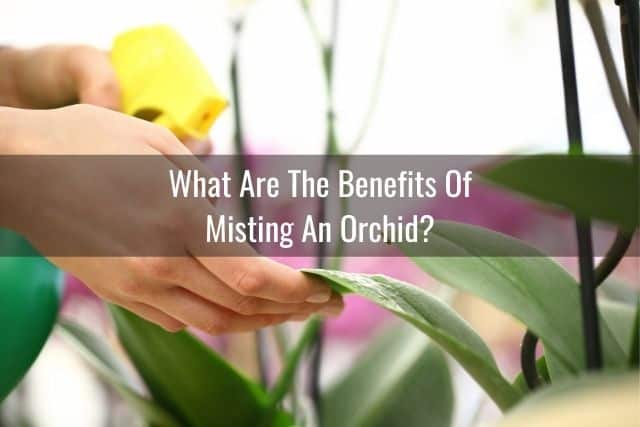
When you mist an orchid, you are essentially covering the roots and the leaves with a fine layer of water. There are several benefits to doing this, which I will outline below.
Increases Humidity
One of the top benefits to misting an orchid is that it can add some humidity to the orchid. All orchids need a certain level of humidity to survive and grow, with some species needing higher humidity levels than others. Misting an orchid is a quick and easy way to briefly increase the humidity around your orchid.
However, when I say brief, I really do mean brief. Misting an orchid provides some transient moisture and humidity, but do not look to misting as a fix for low humidity levels.
There are better ways to go about increasing humidity around your orchids. These other methods will take less effort on your part. I go into this in more detail later on, in the section regarding misting and humidity, if you are curious to know more.
Provides Hydration
Another benefit to misting an orchid is that it provides some water to the orchid. In the wild, orchids are exposed to intermittent rain showers. The water that remains on the orchid leaves and roots provides the orchid with some extra moisture. Occasionally misting your orchid mimics this effect.
Fertilizes Your Orchid
A third benefit of misting your orchid is that you can feed your orchids. You can use specially prepared orchid food mist to both feed and hydrate your orchids at the same time.
Foliar feeding is a popular way to feed many types of plants, not just orchids. In foliar feeding, you spray liquid fertilizer onto your plant’s leaves instead of the soil. The stomata in the leaves open and absorb the food. For example, you can use a diluted Epsom salt solution to foliar feed tomatoes and bell peppers.
However, there are some drawbacks to feeding your orchid by misting them with orchid food.
Fertilizer salts can build up on the orchid leaves. Over time, this can reduce the leaves’ ability to perform photosynthesis and energy harvesting to their full potential.
The water and fertilizer salts may also cause spotting on the orchid leaves, which looks unsightly. You will need to regularly take a soft damp cloth and wipe down the tops and bottoms of the orchid leaves. In the end, this may create more work for you than you want.
While there are some drawbacks to foliar feeding your orchid, some orchid growers still choose to do it for convenience.
The other, more commonly used alternative, is to feed your orchid’s roots. You can find out more about that process by reading about how to fertilize your orchid.
What Are The Risks Of Misting An Orchid?
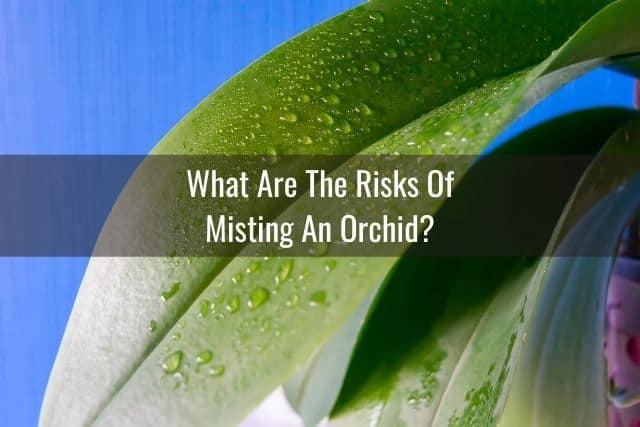
While there are some benefits to misting an orchid, there are also a number of risks of doing so.
If done incorrectly, misting an orchid increases the risk for bacterial or fungal growth on the orchid’s leaves and main stem.
Fungal Spots And Infections
Depending on the weather, water droplets on the orchid leaves can take a long time to evaporate. In cooler weather, water droplets can remain on your orchid for hours. This, combined with little to no airflow, can lead to infections on your orchid.
For example, misting your orchid’s leaves may lead to an fungal infection called brown spot or brown rot. You may not realize it, but water contains a number of microorganisms.
Fungal spots on the orchid leaves appear as brown or yellow soft spots. These areas grow larger over time and become softer and mushier. If left untreated, these infected areas will exude pus or drainage.
Fungal spots can also affect the orchid blooms as well. This happens if contaminated water is sprayed on the blooms and there is poor air circulation.
Constant moisture plus minimal or no air circulation creates a breeding ground for fungus and bacteria. On the orchid blooms, these fungal spots are incredibly unsightly and ruins the beauty of the orchid.
Crown Rot
I have talked extensively about crown rot in another article, including how to spot it and how to treat it. Crown rot is a fungal infection caused by standing water in the orchid’s crown.
This is usually caused by improper watering techniques, but it can also be caused by misting the orchid. Phalaenopsis orchids, in particular, are most susceptible to crown rot because of the structure and sloping of their leaves.
Misting the orchid’s leaves can cause water droplets to run down the sloping orchid leaves and rest in the crown. Even small amounts of standing water can lead to crown rot. You may not even notice there is something wrong until it is too late. Crown rot can quickly damp off and kill an orchid plant.
If you do choose to mist your orchids, be sure to pay attention to where the water droplets land. If any water ends up in the crown, blot it up with the corner of a paper towel until all the water is removed from the orchid’s crown.
Fungus Gnats
Fungus gnats are common orchid pests which are, unfortunately, very hard to get rid of once they are established. They thrive in damp, decaying potting media conditions.
When you mist your orchids daily and don’t give the potting media a chance to dry out, you end up creating the perfect habitat for fungus gnats. Fungus gnats are destructive and can eat away at your orchid roots. You can read more about fungus gnats here.
Salt And Mineral Build-Up On The Leaves
As I mentioned in the section above, misting your orchid can cause water spots to form on the leaves. If you are using an orchid food mist, fertilizer salts can build up on the leaves.
Misting your orchids with hard water can leave mineral deposits on the leaves after the water evaporates. This appears as white spots.
In both cases, this will reduce the effectiveness of the leaves with regards to photosynthesis. If left unaddressed, your orchid may begin to have slower or stunted growth.
How Do You Mist An Orchid?

- To mist an orchid, use a spray bottle with a fine-mist nozzle. Be sure to mist your orchids in the morning, not at night.
- Use clean, room-temperature water and fill up the bottle.
- Hold the mister bottle about 1-foot or 12-inches away from the orchid.
- Lightly mist the orchid leaves and aerial roots. Do not saturate the orchid.
- Use a paper towel to remove any excess water that may have gotten into the orchid’s crown.
Tips For Misting An Orchid
Above, I gave you the quick “how to” for misting an orchid. Now, let’s go into more detail about what you can do to minimize the risk for infections or problems.
Maintain Air Circulation
If you are planning to mist your orchid, be sure to also provide your plant with good ventilation and airflow.
Airflow is key! Proper ventilation and airflow is essential for reducing the risk for mold, bacterial or fungal growth, and disease.
In the wild, orchids are exposed to high humidity, intermittent rain showers and mist. What these orchids have that your potted orchids may not is excellent airflow.
Out in nature, these orchids have constant air movement around the roots and leaves. The air movement helps with evaporation and reduces the chances that water remains on the orchid for long.
What’s more, because epiphyte orchids grow on the sides of trees or branches, the orchids are typically at an angle. This allows for excess water to drip down from the orchid, rather than pool in the crown or sit on the leaves.
When misting your orchids, keep these factors in mind. Above all else, make sure you have good air movement around your orchids and remove standing water from your orchid’s crown.
Use The Right Spray Bottle
Use a fine mist spray bottle. In particular, you want to use a spray bottle with a fine mist nozzle.
The finer the mist, the better. You don’t want to end up spraying your plants with large water droplets.
Try to find a mister specially designed for misting plants. While you can use a regular spray bottle from the hardware store, the spray nozzle on these bottles may not adjust to a fine enough mist for your plants.
A fine mist will mimic more of what orchids are exposed to in nature. This mist will also evaporate faster than large droplets from a regular spray bottle.
Faster evaporation and a finer mist will reduce the risk for rot on the leaves. This is because the water is not left stagnant on the orchid for long periods of time.
Be Mindful Of The Type Of Water Used
Now, should you use rainwater, distilled water, tap water, or filtered water? Obviously, you want to stay away from dirty, standing water where microorganisms might be breeding. But aside from that, what water is best for misting your orchid?
In general, tap water is perfectly fine for misting your orchid. It has already been treated and filtered to some extent by the water company.
If you live in an area with hard water and there are a lot of minerals in the water, however, this can cause unsightly white water spots to appear on your orchid after misting. This by itself is not harmful to your orchid, though it doesn’t look good.
If you don’t wipe off the water spots, though, over time this can have a negative effect on the orchid. The accumulation of minerals from evaporated water can block the stomata and reduce their ability for gas exchange.
To prevent this, you can do one of two things. You can wipe down the orchid leaves with a soft, damp cloth to remove the water spots and minerals. You can also use softened or distilled water to mist your orchid.
Mist The Aerial Roots
When misting your orchids, focus on misting the aerial roots. Aerial roots, or “air roots,” as they are also known as, are found on many orchids, including Phalaenopsis, Oncidium, Cattleya, and Dendrobium orchids.
These aerial roots have a thickened layer of velamen and can absorb moisture and nutrients from the surrounding air.
When misting your orchids, focus on misting the aerial roots so that they do not dry out. This is more important in the fall and winter, when indoor humidity levels drop and aerial roots are at higher risk for drying out.
However, misting provides temporary moisture. If ambient humidity is low, I would instead recommend setting up a cool-mist humidifier near your orchid’s growing spot. This will help improve moisture and humidity for your orchids much better than intermittent misting will.
Don’t Mist The Potting Media
Avoid deliberately misting the potting media. If you are already watering your orchid each week, you don’t need to try to mist the roots visible in the potting media. They are already receiving enough water from regular watering sessions.
Plus, misting the potting media and visible roots won’t be enough to water your orchid anyway. Trying to saturate the potting media by misting will end up causing more problems in the long run.
For example, constantly damp potting media will encourage the growth of fungus gnats and mold. It will also deteriorate and decay faster, leading to root rot.
To prevent fungus gnats from infesting your orchids in the first place, avoid letting the top few inches of your orchid’s potting media remain damp. In other words, don’t mist your orchid’s potting media throughout the day.
Should You Mist Orchid Flowers?
You can, but it is not necessary. Misting the orchid flowers makes them look dewy and hydrated.
On the other hand, it can have the negative effect of creating fungal spots on the blooms. In my opinion, the risk of this happening is not worth the effort of misting the orchid blooms.
Should You Mist Orchid Leaves?
Yes, you can mist the orchid leaves, particularly if you are using a foliar orchid food mist, such as this one by Miracle Gro.
In foliar feeding, the orchid fertilizer is absorbed through the leaves. Some orchid growers choose to use this method to fertilize their orchids.
When you do mist the leaves, do not saturate them. You just want a fine mist to cover the leaves. If you see water start to bead up on the leaves, you have overdone it.
In addition, if you do mist the orchid leaves, check the orchid crown afterwards. Sometimes water can drip down the leaves and into the crown, particularly if you have heavily misted the leaves. Dry up any excess water from the crown to prevent crown rot.
How Often Should You Mist An Orchid?
Some people choose to mist their orchids daily, while others mist their orchids several times a day.
If you do choose to mist your orchids, make sure you mist your orchid in the morning. This is similar to how you would water your orchids in the mornings. It will give the orchids a chance to dry out before nightfall.
If you were to mist your orchids in the evening, the water may remain on your orchids overnight. This will increase the chances that a fungal or bacterial infection can take hold.
Mist Your Orchid On A Regular Schedule
Infrequent, irregular misting can do your orchid more harm than good. In some cases, misting can increase dryness and lead to dehydration. Let me explain how this happens.
When you mist the orchid, it will open up the stomata on the leaves to absorb that extra moisture. However, that mist will soon evaporate. Unfortunately, those stomata will remain open, seeking that extra moisture.
When the stomata are open and the surrounding environment has low moisture or humidity, the orchid ends up losing more moisture than it is able to take in. This is the opposite effect of what you want!
Is It Better To Mist An Orchid Instead Of Watering It?
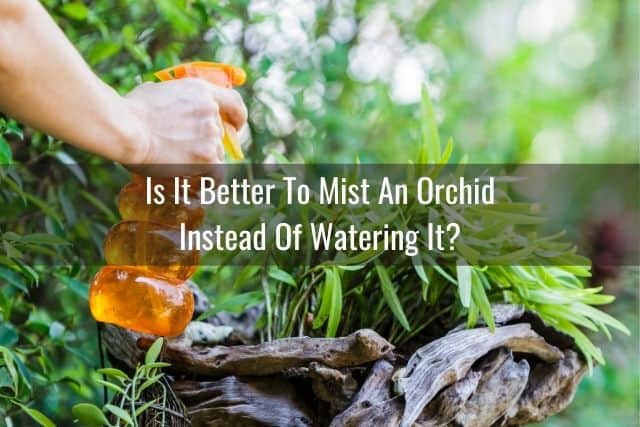
Absolutely not. Misting an orchid doesn’t provide enough water or moisture to an orchid for it to survive. Even daily misting will not be enough to meet an orchid’s water needs.
An orchid needs regular watering, usually once a week on average. The soaking method is the easiest and in my opinion, best, method for watering your orchids. You can read more about how to water your orchid here.
Here is why watering your orchid is a much better way to hydrate it, as opposed to misting:
1.Watering your orchid just once a week in the mornings is much less work. It is also better for your orchid.
2. Even if you heavily mist the potting media and potted roots, the truth is, you only get the top couple inches of potting media wet. The rest of the roots further down will not get enough water. These roots will end up drying and shriveling up.
You may not notice this at first, since this is a slow and gradual process. But over time, choosing to only mist your orchid will lead to under-watering problems. These include wilted leaves, stunted growth, and eventual death of the plant.
3. Even if you heavily mist the orchid leaves, it still is not going to be enough water for your orchid. The leaves can only absorb so much moisture at a time.
4. Orchid roots have a layer of velamen. Because of this, orchid roots are specially designed to absorb water and nutrients. Water absorption through the leaves is secondary and an extra bonus to what the orchid gets from the roots.
5. More importantly, frequent or heavy misting of your orchid will lead to fungal infections and rot. Keeping the leaves and superficial roots constantly wet will lead to growth of fungus gnats, rot, brown spot, and other problems.
Does Misting An Orchid Add Humidity? How Much Of A Difference Does It Make?
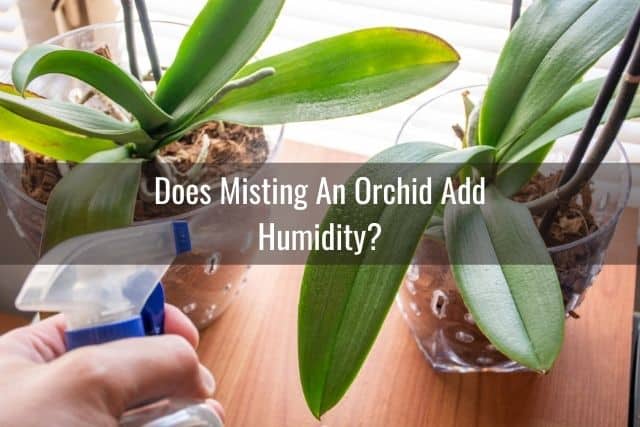
I briefly touched upon this above, but misting an orchid adds minimal amounts of humidity to an orchid. Depending on the weather, the effects of misting may be very short-lived if it is hot and the water evaporates quickly.
In fact, to keep humidity levels up, you may end up needing to mist your orchid several times a day. This can turn out to be quite a chore. Factor in needing to wipe down excess water from the leaves or crown after each misting session, and it may be more work than you want.
How To Provide Humidity To Your Orchid
As I mentioned above, irregular misting of your orchid can actually end up drying it out further. This is because when you mist an orchid, the stomata open up to absorb the extra moisture. The longer they stay open, the more moisture they will lose to the surrounding environment if surrounding humidity levels are low.
There are better ways to add humidity to your orchid. Keep reading to learn more.
Use A Hygrometer
To figure out the current humidity levels in your orchid’s growing area, invest in a hygrometer. This will allow you to keep track of humidity levels over a 24-hour period.
Also, learn what your orchid’s particular species requires in terms of humidity. For example, Phalaenopsis orchids need anywhere from 40-60% humidity levels in order to thrive. By using a hygrometer, you will be able to tell whether your orchid needs more humidity or not.
Use A Humidifier Or Humidity Tray
If your main goal is to add humidity to your orchid’s growing area, you are better off using a humidifier or humidity tray.
If you need to increase humidity levels, read this article on five ways to add humidity to your orchid’s growing area.
As you increase humidity in your orchid’s growing area, be mindful of the temperature and air circulation. Maintain good airflow around your orchid to prevent fungal and bacterial growth.
Group Your Plants Together
You can also cluster orchids and other houseplants together. Having multiple plants in proximity will naturally increase humidity in that area. If you do this, just be careful to leave adequate spacing between and around the pots to allow for airflow.
Keep Orchids In The Bathroom
Placing your orchids in the bathroom is also a great way to expose your orchid to high humidity levels after showers. Most bathrooms also have good natural lighting and windows that can be opened for air circulation. In addition, orchids in the bathroom can improve feng shui and luck. This makes bathrooms favorite locations for potted orchids.
Final Thoughts
In general, I would not recommend misting your orchid. In my opinion, the risks outweigh the benefits. You will find that there are much better, more effective ways of watering and humidifying your orchids. If you want to fertilize your orchids, feeding the orchid roots is a more preferred method of fertilizing orchids, as opposed to foliar feeding.
All that said, there are definitely some orchid growers who enjoy misting their orchids each morning as part of their routine orchid care. I don’t want you to think that misting your orchid is terrible or equals a death sentence for your plant. It really doesn’t. A lot of it depends on the circumstances and how you mist your orchid.
In the end, it is ultimately your choice to care for your orchids as you like. That’s why I wanted to lay out the pros and cons to misting your orchid, as well give you information about how to do it correctly. When you mist your orchid, remember that airflow and not overly saturating your orchid are key.
Hope this helps! As always, happy orchid growing.
If you enjoyed this article, please pin it and share!
